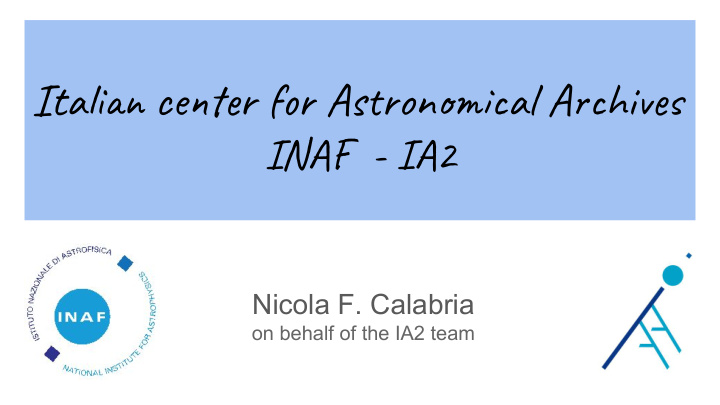



Ita���� ce���r ��� As��on����al A��hi��� IN�� - I�2 Nicola F. Calabria on behalf of the IA2 team
outline ● data center overview ● data ingestion and distribution landscape ● web and interoperable interfaces ● user authentication & authorization ● modular solution to VO services
IA2: goals and main activities IA2 is the only INAF e-infrastructure for astronomical data storage and preservation. IA2 is supported by INAF since 2005 IA2 aims at: ● coordinating different national initiatives to improve the quality of astrophysical data services; ● coordinating the developments and facilitating access to data for research purposes. IA2’s main goals consist in: ● data archiving systems and safety, including data hosting and data curation and preservation; ● data and metadata distribution over geographical sites and access services, including VO aware resources.
IA2 landscape IA2 manages data from: - TELESCOPES (raw; INAF ground based) - SURVEYS (raw and/or calibrated) - SIMULATIONS (exoclimates, spectral libraries)
IA2 data resources Telescope & Projects’ data managed/hosted: - TNG : all instruments - LBT : all instruments except LBTI - Asiago Observatory : all instruments - Serra La Nave - SVAS (educational) - ExoClimates (simulations) - Intrigoss (simulations) - Prisma (meteoric datasets) - Radio (Medicina, Noto, SRT) - BaSTI (simulations) - MWA (mirror, in progress) SRT-Medicina-Noto Radio Telescopes
IA2 geographical landscape Heidelberg Trieste Bologna SRT (Cagliari) Tucson Serra La Nave (Catania) Perth
NADIR Software ● NADIR ● Preprocessor ● Fits Importer ● Radio Data Importer ● Meta and Data Exporter/Importer ● Data Distribution / Radio Data Distribution ● Administration Interface
FITS and MBFITS HDF5 coming soon (SHARK-VIS@LBT)
IA2 data discovery and access ● Web portals ○ config-generated (APOGEO) configuration ■ TAP_SCHEMA 1. query & form customization 2. portals are TAP clients ■ ● Virtual Observatory services ○ (under reshaping - see later) ○ TAP (will be) TAPlib (ARI/CDS) ■ TASMAN manager ■ ○ Cone Search ○ SIAP (in progress v. 2.0) ○ SSAP (future) IA2 is also planning to offer a VOSPace (already has a minimal user space)
IA2 Service Architecture
RAP and Grouper Courtesy of F. Tinarelli RAP: account linking - Grouper: group based authorization service
Distributed architecture for services modular approach ● Interface runs on a glassfish server ○ passive interface: doesn’t perform any validation on input ● Backend ○ Configuration server ■ manages active services list and their configuration ● data db ● TAP_SCHEMA (metadata) db ● message broker instance ● logging service ○ Service server ■ performs service specific tasks according to call ○ Logging server ■ optional (currently minimal)
Messaging System ● AMQP based ○ RabbitMQ broker Advanced Message Queing Protocol (AMQP) ● JSON formatted messages ○ queue identification + actual message ● Can run on a dedicated machine ○ helps in distributing the architecture ● Known issue ○ messaging is completely custom ■ possible future solution describing the system through a workflow language
Cone Search and SIAP-2.0 (status) ● New packages incoming for code reuse and interchangeability ● Query String Parser ○ validates mandatory parameters ● Input Parser ○ particularly useful for SIA: manages ranges parsing and internal representation ● Query Builder ○ validates parameters values and generates SQL queries ● VOTable generator (simple and light) ● Interface-implementing Enums ○ allow extension of supported parameters on the fly ○ C-printf like syntax for complex parameters to be parsed (e.g. POS) ○ Interfaces allow code interchangeability
Summary ● IA2 keeps managing heterogeneous data resources ○ distributed archival solution is in place ● web “portals” and VO-based API architecture are evolving ○ heritage resources will be moved to new solutions ○ modular solution should help software integration ● resource interoperability still lacking ○ but we’re working on it ● moving from data archive to data providing and service center is a long way to go
Recommend
More recommend